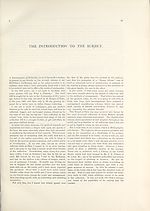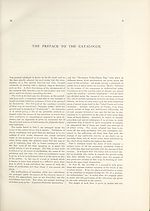Bibliography of the writings, general, special and periodical forming the literature of philately
(12) Columns vii and viii
‹‹‹ prev (11)
Columns v and vi
(13) next ›››
Columns ix and x
Download files
Complete book:
Individual page:
Thumbnail gallery: Grid view | List view

THE INTEODUCTION TO THE SUBJECT
Vll
«• •
Vlll
Experience had taught me that others would have
heard the rumours as soon as, or before, I did, and that
prompt action alone would be of use. After a short time
I had the pleasure of learning that my overtures were
acceptable and that the celebrated Tiffany Library was
on its way across the seas. In due course a good many
tons of books were safely delivered at Cavendish Square.
In the meantime, I had been fortunate enough to
secure the assistance of Mr. E. D. Bacon, than whom no
one in this section of the world's learning is better
known.
In the course of time we got all the books shelved and
into a provisional scheme of order. The general lines
of a catalogue were considered, and I determined to
separate the Library into two main divisions, the one
comprising all the writings on the subject as individual
works, the other consisting entirely of periodical litera¬
ture and journals. Much had to be done to restore the
continuity of the collection for the years since the death
of Mr. Tiffany, 1897-1902, and then to endeavour to fill
up gaps and wants. Mr. Bacon prepared lists of de¬
siderata, and for some years I advertised largely, with
a considerable amount of success. In this I was greatly
assisted by Messrs. Stanley Gibbons Limited, by the
use of their "Monthly Journal," which is to be found
in all parts of the civilised world.
Since then no opportunities have been passed of adding
to the Library, either in single purchases or by buying
en masse. The most important acquisition I have made
in this way occurred some three years ago on the death
of Herr Heinrich Frankel, who was Librarian of the
leading Philatelic Society in Berlin for many years, and
who was possessed of one of the best Libraries on the
Continent. Herr Frankel's collection was very rich in
European and especially in early German literature, a
section where I was but poorly supplied. I was fortunate,
therefore, in being able to secure it, and then, having
taken out such works as I was in need of, I transferred
the whole of the remaining volumes to the Library of
the Royal Philatelic Society of London, and thus every
portion will be \itilised to the best advantage.
The first issue of Postage Stamps was made on tlie
6th May, 1840—and the first book known to have been
printed on the subject was published in December, 1861.
In those twenty-one years, the pursuit had grown suffi¬
ciently to induce persons to risk printing and catering
to an increasing demand. J'rom that moment a steady
movement forward has continued, and I consider that
no other pursuit has evoked so large an output of litera¬
ture in the short space of fifty years.
I will go further—I know of no branch of writing in
which there exists so great a number of actual rarities.
Little journals exist by the score whose lives did not go
beyond a week and whose existence is only known by
single copies. They are found in Manuscript, in Hecto¬
graph, in Lithography and typewritten and in printed
form of the roughest description, with illustrations in
the text very nearly approaching in ugliness to some
of the stamps they are anxious to describe.
Now a great change has come about—both in the
methods of collecting and arranging the collections
which are made, and in the books and the journals
which abound. The illustrations and general appear¬
ance of these publications compare favourably with any
similar work.
It may well be understood that I do not possess every
one of these rare little works, and further that it is
probable others may still exist unknown to me. How¬
ever, in order to make this catalogue of more general use,
I have endeavoured to describe everything that has
come under my notice. I could only effect this purpose
by appeal to friendly collectors, and I am most anxious
here to record my most grateful thanks for the generous
help which has been afi'orded to Mr. Bacon and to my¬
self by the following gentlemen :—
P. J. Anderson (Aberdeen).
F. A. Bellamy (Oxford).
H. Clark (Angmering).
J. A. Cook (Waterloo, Iowa, U.S.A.).
A. Dethier (Bruxelles).
H. E. Deats (Flemington, New Jersey, U.S.A.).
Dr. Emilio Diena (Rome).
Abel Fontaine (Buenos Ayres).
W. V. Morten (Leeds).
C. A. Nast (Denver, Colorado, U.S.A.).
A. J. Pares (Toulon).
F. J. Peplow (Dulwich).
E. B. Power (New York).
W. R. Ricketts (Forty Fort, Pennsylvania, U.S.A.).
Dr. Otto Rommel (Leipzig).
B. T. K. Smith (London).
V. Suppantschitsch (Graz).
The late H. Frankel (Berlin).
Many rare little volumes are described in the follow¬
ing pages, from the unique copies in their possession,
thereby greatly adding to the interest of the Catalogue.
CRAWFORD.
2, Cavendish Square, W.
February, 1911,
Vll
«• •
Vlll
Experience had taught me that others would have
heard the rumours as soon as, or before, I did, and that
prompt action alone would be of use. After a short time
I had the pleasure of learning that my overtures were
acceptable and that the celebrated Tiffany Library was
on its way across the seas. In due course a good many
tons of books were safely delivered at Cavendish Square.
In the meantime, I had been fortunate enough to
secure the assistance of Mr. E. D. Bacon, than whom no
one in this section of the world's learning is better
known.
In the course of time we got all the books shelved and
into a provisional scheme of order. The general lines
of a catalogue were considered, and I determined to
separate the Library into two main divisions, the one
comprising all the writings on the subject as individual
works, the other consisting entirely of periodical litera¬
ture and journals. Much had to be done to restore the
continuity of the collection for the years since the death
of Mr. Tiffany, 1897-1902, and then to endeavour to fill
up gaps and wants. Mr. Bacon prepared lists of de¬
siderata, and for some years I advertised largely, with
a considerable amount of success. In this I was greatly
assisted by Messrs. Stanley Gibbons Limited, by the
use of their "Monthly Journal," which is to be found
in all parts of the civilised world.
Since then no opportunities have been passed of adding
to the Library, either in single purchases or by buying
en masse. The most important acquisition I have made
in this way occurred some three years ago on the death
of Herr Heinrich Frankel, who was Librarian of the
leading Philatelic Society in Berlin for many years, and
who was possessed of one of the best Libraries on the
Continent. Herr Frankel's collection was very rich in
European and especially in early German literature, a
section where I was but poorly supplied. I was fortunate,
therefore, in being able to secure it, and then, having
taken out such works as I was in need of, I transferred
the whole of the remaining volumes to the Library of
the Royal Philatelic Society of London, and thus every
portion will be \itilised to the best advantage.
The first issue of Postage Stamps was made on tlie
6th May, 1840—and the first book known to have been
printed on the subject was published in December, 1861.
In those twenty-one years, the pursuit had grown suffi¬
ciently to induce persons to risk printing and catering
to an increasing demand. J'rom that moment a steady
movement forward has continued, and I consider that
no other pursuit has evoked so large an output of litera¬
ture in the short space of fifty years.
I will go further—I know of no branch of writing in
which there exists so great a number of actual rarities.
Little journals exist by the score whose lives did not go
beyond a week and whose existence is only known by
single copies. They are found in Manuscript, in Hecto¬
graph, in Lithography and typewritten and in printed
form of the roughest description, with illustrations in
the text very nearly approaching in ugliness to some
of the stamps they are anxious to describe.
Now a great change has come about—both in the
methods of collecting and arranging the collections
which are made, and in the books and the journals
which abound. The illustrations and general appear¬
ance of these publications compare favourably with any
similar work.
It may well be understood that I do not possess every
one of these rare little works, and further that it is
probable others may still exist unknown to me. How¬
ever, in order to make this catalogue of more general use,
I have endeavoured to describe everything that has
come under my notice. I could only effect this purpose
by appeal to friendly collectors, and I am most anxious
here to record my most grateful thanks for the generous
help which has been afi'orded to Mr. Bacon and to my¬
self by the following gentlemen :—
P. J. Anderson (Aberdeen).
F. A. Bellamy (Oxford).
H. Clark (Angmering).
J. A. Cook (Waterloo, Iowa, U.S.A.).
A. Dethier (Bruxelles).
H. E. Deats (Flemington, New Jersey, U.S.A.).
Dr. Emilio Diena (Rome).
Abel Fontaine (Buenos Ayres).
W. V. Morten (Leeds).
C. A. Nast (Denver, Colorado, U.S.A.).
A. J. Pares (Toulon).
F. J. Peplow (Dulwich).
E. B. Power (New York).
W. R. Ricketts (Forty Fort, Pennsylvania, U.S.A.).
Dr. Otto Rommel (Leipzig).
B. T. K. Smith (London).
V. Suppantschitsch (Graz).
The late H. Frankel (Berlin).
Many rare little volumes are described in the follow¬
ing pages, from the unique copies in their possession,
thereby greatly adding to the interest of the Catalogue.
CRAWFORD.
2, Cavendish Square, W.
February, 1911,
Set display mode to: Large image | Transcription
Images and transcriptions on this page, including medium image downloads, may be used under the Creative Commons Attribution 4.0 International Licence unless otherwise stated. ![]()
| Bibliotheca Lindesiana catalogues > Bibliography of the writings, general, special and periodical forming the literature of philately > (12) Columns vii and viii |
|---|
| Permanent URL | https://digital.nls.uk/105642985 |
|---|
| Description | Privately printed catalogues of the special collections of the Bibliotheca Lindesiana, the family library of the Earls of Crawford and Balcarres. Reformation Tracts, English Newspapers and De Bry Collection catalogues provide the only record of the contents of these collections. Also include catalogues of Bibliotheca Lindesiana collections now held elsewhere. |
|---|